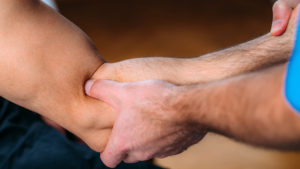
Graston technique being applied on patient
Can muscle adhesions be healed? Using the Graston technique, we address adhesions and scar tissue that are causing pain, inflammation and reduced range of motion. This is an instrument-assisted soft-tissue mobilization technique that is used to treat multiple areas of the body. Here at Barnes Chiropractic, we’ve seen patients find relief from deep, restrictive muscle adhesions that left them unable to freely do the things they enjoy.
What You Can Expect From the Graston Technique
The premise of the Graston technique is fairly simple. It actually mirrors many ancient techniques that promote healing by stimulating blood flow. During your sessions, we’ll use a special instrument in combination with massage to stretch and relax your muscles. Typically, we will have you warm up a bit prior to your treatment to prime your soft tissue for stimulation. Next, we’ll begin the process by using a series of strokes with our massage instrument. As work is being done on your soft tissues, we’ll observe muscle reactions and vibrations to detect any areas that need special focus. If you’d like to learn more about how the Graston technique can be integrated into a plan for helping you to enjoy pain relief, better flexibility or restored range of motion, don’t hesitate to reach out to us here at Barnes Chiropractic in Centennial, Colorado.
The Benefits of the Graston Technique
The main benefit of the Graston technique is that it increases blood flow to the treated area. If you’re experiencing adhesions and scar-like activity in your soft tissues, the area likely has reduced blood flow that is robbing it of oxygen. Without proper access to oxygen, the damaged tissue simply does not have the nutrients needed for cellular regeneration and healing. The benefit of the Graston technique is that it stimulates blood flow directly to the area through a series of strategic movements. Many people find that they immediately see improvements in movement patterns. This technique is ideal for treating sore, tender, inflamed and pulled tissues like muscles, ligaments and tendons. Many people with general inflammation find that it helps to get their bodies back in balance.
Frequently Asked Questions About the Graston Technique
Does the Graston Technique Hurt?
Like many techniques designed to stimulate blood flow, the Graston technique does use pressure. This treatment is not considered painful. However, many patients do experience some pressure and minor discomfort during treatment. It’s even possible for light bruising to occur. It is not a sign that the treatment isn’t working if you don’t experience pain or discomfort. Some people aren’t bothered by the amount of pressure used.
How Many Treatments Are Required to See Benefits From the Graston Technique?
Many patients experience significant improvements after just one session. However, one visit often isn’t enough to address adhesions and scar-like formations on muscle tissue. For long-term restoration, a plan involving three to four treatments may be suggested.
